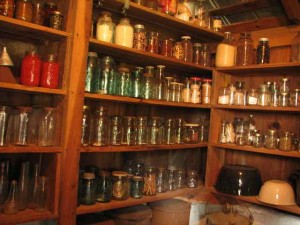 A generation or two ago, families had the good sense to always maintain a good food storage program because they understood that bad things can happen to food supplies. At some point, America became complacent and assumed that there would never be a time when we couldn’t get in the car, drive to the grocery store or restaurant, and find exactly what we wanted in bountiful quantities at cheap prices. That is not a good assumption. Now things are starting to return to a more sane idea that every family should have their own secure food storage plan. Food storage is still viewed as a somewhat quirky, semi-paranoid idea, but anyone reading The Southern Agrarian understands that it is a very wise move.
A generation or two ago, families had the good sense to always maintain a good food storage program because they understood that bad things can happen to food supplies. At some point, America became complacent and assumed that there would never be a time when we couldn’t get in the car, drive to the grocery store or restaurant, and find exactly what we wanted in bountiful quantities at cheap prices. That is not a good assumption. Now things are starting to return to a more sane idea that every family should have their own secure food storage plan. Food storage is still viewed as a somewhat quirky, semi-paranoid idea, but anyone reading The Southern Agrarian understands that it is a very wise move.
These are some notes compiled by a relative who spent forty days living entirely off of stored food supplies. I have known him for my entire life. He is a physician, and looks at this from a very analytical and physiological standpoint. I found myself modifying our family’s own food storage program after following his experience during those forty days.
- CANNED GOODS—Canned goods have a limited shelf life and should not be part of a survival food program unless they are rotated as part of one’s regular eating. Older foods may not make a person sick, but they taste funny and stress the digestion.
- FREEZE-DRIED FOODS—Freeze-dried foods have a very long shelf life and are quite palatable and satisfying, both the vegetables and the meats.
- OILS—Oils are not sold as part of a survival package. They must be acquired separately. They are needed for cooking, palatability, and calories. Vegetable oils probably have important essential fatty acid nutrients, too.
- NUTS—Easy to store, and a satisfying supplement to many foods.
- GRAINS—RICE, RICE, RICE. Easy to prepare, easy to store, goes well with other foods. More palatable than freeze-dried potatoes, easier to prepare than breads. (If I had it to do over, I would have bought more rice and less wheat. THIS WAS ONE OF THE BIG LESSONS OF MY EXPERIENCE.)
- LEGUMES—Easy to store, easy to cook, satisfying. (Legumes, along with rice, became the staples to which I added other things.)
- SEASONINGS—Seasonings are critical to making legumes palatable. They are sold as packets in grocery stores next to the legumes (dried beans).
- DIETARY SUPPLEMENTS—Fish oil caps, and hard-coat (i.e. oxygenation-resistant) vitamin pills. Just in case something is missing from the other foods.
- BULK SUPPLEMENTS—Fiber supplements and perhaps mag citrate. Under survival conditions they can make it so you have one less thing to worry about.
- PRESERVATION—Many foods come in large containers and once opened, unused portions are susceptible to spoilage unless properly stored. I use mason jars and evacuate air with a vacuum pump. (Completely filling the mason jar is another way to minimize the amount of oxygen in the jar, too.) Weevils can destroy grain supplies if grains are exposed to oxygen.
- MISC—Salt; sugar; anything you use for cooking. Tincture of iodine, to make drinking water safe. (Think of other supplies.)
- PRACTICE—If you are not experienced, you will neglect supplies that are important and overstock supplies that are unimportant.
- PRESERVATION II—Light, heat, moisture, oxygen. To maximize shelf-life, keep these to a minimum.
Read more: http://www.southernagrarian.com/food-storage-wisdom/























